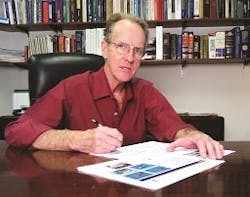During his award lecture, Dr. Walter M. (Mike) Doyle said that upon reflecting over his more than 50-year career in optics and spectroscopy, three main things seemed to be attributable to his success: studying fertile areas, collaboration and having the courage to see things through to their completion — even in the face of seemingly insurmountable odds. Pharmaceutical Manufacturing took the opportunity to ask Doyle how these three attributes could be exploited during the next phase of his long career, and how his experience in optics and spectroscopy might be focused, studying ways to overcome the complex issues surrounding the spectroscopic analysis of tissue cultures and fermentation systems.
PhM: What challenges exist for the molecular spectroscopist when confronted with measuring tissue culture or fermentation processes?
Doyle: “I must preface my answer by admitting that I do not know anything about cell culture or microbiology fermentation systems. However, when we attempt to measure cellular or microbiological systems with molecular spectroscopy, what we encounter is mainly water, a cloudy environment, and an environment containing gaseous bubbles to name a few. Not really a good environment for performing spectroscopic measurements. The spectra we do obtain would have vibrations from lots of vibrating molecules, and those vibrations would be emanating from both the solid matter and the liquid medium. To make sense out of any measurement you would need to really think about instrument design, the sampling interface, the sampling process, and many other factors impacting the measurement to really get anything useful out it.”
PhM: Your candor is appreciated, but because of the problems that exist for a molecular spectroscopist when measuring living matter, the subject continues to demand examination. Understanding how to measure and control biopharmaceutical processes using this branch of spectroscopy has potential. Your success in optics and molecular spectroscopy may make this a fertile area for you: Is the measurement of cell culture and microbiological fermentation systems something that you would explore with Axiom Analytical Inc.?
Doyle: “Interesting question. I have thought about this, and since you have also begun to question me as to whether or not this discipline does present itself as a fertile area of study, would there be opportunities to collaborate and would I have the fortitude to pursue this field on business grounds? I think there exist reasons enough on all three merits for a serious look at the use of molecular spectroscopy as another process control tool for biopharmaceutical application. I am aware of serious attempts to apply ultraviolet/visible/NIR spectroscopy to measuring at/in/on-line cell culture and fermentation systems, but it is not known (at least publicly) how many of these attempts make it to the commercialization stage.”
PhM: Let’s shift the focus a bit on to the sampling interface, your area of expertise. Being a pioneer in the development and use of Mid-IR spectrophotometers in the earlier part of your career and now sampling accessories for the on-line analysis of liquids, gasses, slurries and powders; where, in your mind, would be the best place to start in designing an on-line optical system for measuring and controlling cell culture and microbiological fermentation systems?
Doyle: “Well, we first need to select a region of the electromagnetic spectrum we want to exploit and then we would need to think through the molecular properties we want to try to measure and control. As I stated earlier, we are going to be in an aqueous environment; there are going to be solids as well gasses present. In order to get useful, specific information about the vibrational modes emanating from any specific molecule, I believe (at least right now) that the optimal phase to measure in would be the liquid phase and that ultraviolet/visible spectroscopy could be useful as there are UV chromopheres that would yield information about the state of the cellular and microbiological processes.”
PhM: Axiom specializes in sampling accessories. So what design requirements would need to be made going from measuring organic reactions to cell culture or microbiological fermentation systems?
Doyle: “Well, the fiber bundle configuration would have to be made smaller, like a catheter. It is possible to start thinking on the scale that attenuated total reflectance (ATR) are designed and perhaps get them smaller still. You could develop micro ATR in Mid-IR and NIR as well.”
PhM: So how would you proceed from a business perspective to create ATR micro accessories for measuring and controlling cell culture and microbiological fermentation systems?
Doyle: “I would proceed by doing basic research on what has been developed along these lines already. I would have to collaborate with experts in the field of cell culture and microbiological fermentation, and I would seek out people I have collaborated with in the past to ensure I am not designing systems just based on how I see things.”
PhM: What other possibilities do you envision exist to further exploit optical and spectroscopic measurements?
Doyle: “I believe there is room for exploring in this area further; I am not certain that opportunities in this area have been fully investigated.”
PhM: It’s apparent that this field is ripe for further R&D so cell culture/microbiological fermentation experts can be better equipped to understand these complex systems and also to be able to measure and control them better than they do now. Congratulations on being named the 2014 Coblentz Society – Williams-Wright honoree.







